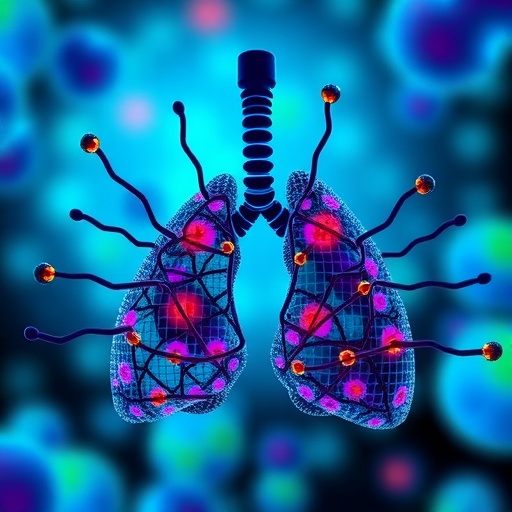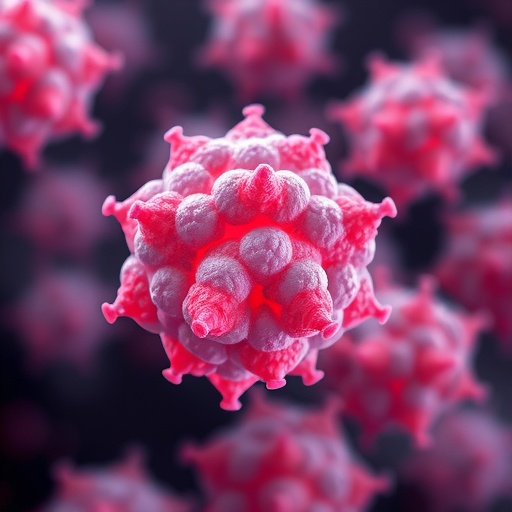
In a groundbreaking study published in the Journal of Cancer Research and Clinical Oncology, a team of researchers led by Yang, Xu, and Lu has unveiled crucial insights into the complex interactions between epithelial cells and fibroblasts in lung adenocarcinoma. Utilizing cutting-edge single-cell and spatial transcriptomics technologies, this research dives deep into the cellular microenvironments of lung tumors, revealing intricate networks of communication that fuel cancer development and progression. The implications of these findings could reshape therapeutic strategies in oncology, offering hope for patients battling this formidable disease.
Lung adenocarcinoma, one of the most prevalent subtypes of lung cancer, represents a significant challenge due to its heterogeneity and complex tumor microenvironment. Previous studies have primarily focused on individual cell types within the tumor; however, the interactions between different cellular components have often been overlooked. The researchers aimed to bridge this gap by employing advanced methodologies that allow for the simultaneous analysis of multiple cell types within their native contexts.
Through single-cell transcriptomics, the team was able to profile thousands of individual cells from patient-derived samples, shedding light on the diversity of cell populations present within the tumors. This approach not only highlighted the distinct expression profiles of epithelial and fibroblast cells but also facilitated the identification of previously unrecognized subpopulations within these categories. The data revealed a sophisticated interplay between tumor-associated fibroblasts and neoplastic epithelial cells, suggesting that these interactions play a pivotal role in tumor progression.
Spatial transcriptomics further complemented the single-cell analysis by providing a spatial map of gene expression within the tumor microenvironment. This technique enables researchers to visualize the precise locations of different cell types and assess how their proximity influences cellular behavior. The results showed that epithelial cells and fibroblasts were not randomly distributed; instead, they formed specific niches that were critical for tumor sustenance and growth. Such insights underscore the need to consider spatial organization when developing therapeutic interventions.
A particularly intriguing finding from the study was the identification of signaling pathways enriched in the epithelial-fibroblast interactions. The researchers noted that these cellular dialogues were mediated by various growth factors and cytokines, with significant implications for the proliferation and survival of cancer cells. For instance, the expression of transforming growth factor-beta (TGF-β) and fibroblast growth factor (FGF) was notably elevated in areas where epithelial and fibroblast cells closely interacted. These factors are known to contribute to tumorigenesis, hinting at their potential as therapeutic targets.
In addition to elucidating the molecular mechanisms underpinning epithelial-fibroblast interactions, this research also sheds light on the potential for developing novel treatment approaches. Targeting the specific pathways that facilitate these interactions may inhibit tumor growth and even sensitize cancer cells to existing therapies. The study authors propose that the integration of targeted therapies with traditional chemotherapy could enhance treatment efficacy and improve patient outcomes.
The implications of this research extend beyond lung adenocarcinoma; the methodologies and insights gained could be applied to various malignancies characterized by complex microenvironments. By deciphering the cellular interactions that drive cancer progression across different tumor types, researchers may uncover universal mechanisms of tumor biology. This could pave the way for the design of multifaceted therapeutic strategies tailored to individual patient profiles, a hallmark of personalized medicine.
Moreover, the study emphasizes the importance of collaboration in cancer research. The interdisciplinary nature of the project, combining expertise from genomics, pathology, and bioinformatics, highlights how innovative approaches can lead to transformative discoveries. As researchers continue to unravel the complexities of cancer biology, collaborative efforts will be essential in overcoming the challenges posed by tumor heterogeneity and microenvironmental factors.
The potential for these findings to impact clinical practice is immense. With lung adenocarcinoma remaining a leading cause of cancer-related deaths globally, the necessity for refined therapeutic strategies is paramount. By focusing on the tumor microenvironment, this research not only offers new insights into the biology of lung cancer but also serves as a reminder of the intricate relationships that govern tumor development.
In conclusion, the research led by Yang, Xu, and Lu represents a significant step forward in our understanding of epithelial-fibroblast interactions in lung adenocarcinoma. By employing advanced single-cell and spatial transcriptomics techniques, the team has provided a nuanced view of the cellular landscapes within tumors. The insights gained from this work hold tremendous promise for devising effective treatment strategies that could ultimately improve the prognosis for patients facing lung adenocarcinoma. As the scientific community digests these findings, one can only hope that they catalyze further research and innovation in the fight against cancer.
Subject of Research: Epithelial-fibroblast interactions in lung adenocarcinoma.
Article Title: Decoding epithelial–fibroblast interactions in lung adenocarcinoma through single-cell and spatial transcriptomics.
Article References: Yang, J., Xu, Q. & Lu, Y. Decoding epithelial–fibroblast interactions in lung adenocarcinoma through single-cell and spatial transcriptomics. J Cancer Res Clin Oncol 151, 221 (2025). https://doi.org/10.1007/s00432-025-06250-6
Image Credits: AI Generated
DOI:
Keywords: Lung adenocarcinoma, single-cell transcriptomics, spatial transcriptomics, epithelial-fibroblast interactions, tumor microenvironment, therapeutic strategies.
Tags: advanced cancer research methodologiescancer development communication networkscellular heterogeneity in tumorsepithelial and fibroblast interactionsinsights into lung cancer progressioninterdisciplinary cancer research findingslung adenocarcinoma researchpatient-derived lung cancer samplessingle-cell transcriptomics technologiesspatial transcriptomics in cancertherapeutic strategies in oncologytumor microenvironment analysis




